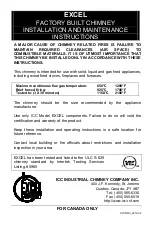
23
COMBUSTION PHASES IN A CONTINU-
OUS FIRE SITUATION
You should not continuously supply firewood to the
fireplace because in this way you interrupt combustion
transformation phases and performance decreases.
First phase
: loss of humidity and combustion of
gas substances.
Second phase
: transformation of firewood into coal,
increase of heating value and weight loss.
Third phase:
maximum combustion performance.
Fourth phase:
slow combustion and progressive power
decrease.
Clean firewood combustion is a process similar to na-
tural decomposition, which means that the CO2 (car-
bon dioxide) being freed does not increase or alter
the original concentration of CO2 in the atmosphere.
FLUE
The existing duct or the one to be built must comply
with the existing regulations.
Existing duct
Make sure that it is well sealed.
Make sure that it is not connected to another fire-
place.
Make sure that the chimneypot is in good conditions
and that the height and diameter are correct.
Building of a metal duct
The material to be used is AISI 316 double-walled
stainless steel, with a 4/10 minimum thickness (the
best value would be 1 mm), installed according to the
rules of the manufacturer.
Building a refractory material duct
This duct is built with three concentric layers, each one
with a specific function:
− The first layer of refractory material guarantees the
waterproof nature of the product, air-tightness and re-
sistance to corrosion and heat.
− The second intermediate layer, apart from the in-
sulating function, provides for longitudinal and trans-
verse expansion of the refractory material with re-
spect to the external wall.
− The third external layer performs insulating, protect-
ing, guiding and containing functions typical of refrac-
tory material.
This kind of flue is the optimal solution in terms of func-
tionality and endurance in time.
Chimney
The chimney will be rainproof.
The thermal resistance of chimney walls should be
at least 0.43 m2kw.
The chimney must extend 1.20 m over the ridge of
the roof.
Thermal insulation of the duct
The passage of the duct through a wall of an inhab-
ited room shall be isolated with fireproof material in
order to avoid fire; the minimum distance between the
duct and all combustible elements (beams, wooden
floors, etc.) will exceed 16 cm.
AIR INLET
− It should be placed directly outside or inside a ven-
tilated room, with the right dimension and with the
protection of a grid.
− Insulation of the breast wall: insulation is fundamen-
tal for light structures, and it is also recommended to
avoid loss of heat, thus achieving better thermal ef-
ficiency.
− Lifting of the compact fireplace: it is possible up to
the height indicated in the design using, for example,
Gasbeton ® blocks with the suitable shape.
− Place the marble/stone covering: with the right
shape according to the design. Provide a stable sup-
port at least on three points or, if it is overhanging,
provide suitable hidden metal supports. The width of
the marble/stone top in front of the fireplace should
be more than 30 cm if the floor is made of wood, fit-
ted carpet or any other inflammable material.
− If there is a wooden lintel, it should be protected.
− It is compulsory to build the hood with insulating
and fireproof materials. The hood is generally made
of plasterboard; to avoid overheating it is necessary
to create a ventilation system in the hood through
grids, placed in the correct places, to allow the air
to circulate; grids, however, have to be placed at the
highest point, but never less than 30 cm from the ceil-
ing with grids with a surface of 600 cm2.
Optimum usage
Do not force the fireplace when used for the first
times; during the first few days use the equipment at
50% in order for its components to expand and set-
tle evenly. Always use dry firewood with a maximum
humidity of 15%; always charge ¾ big pieces sepa-
rated in time, avoid continuously opening the door
to add small pieces of wood because this increases
firewood consumption; control combustion by means
of the primary air inlet.
Notes on fuels
Allowed: firewood, lignite, compressed logs.
Do not burn: cardboard, wooden pallets, plastic, al-
cohol, gas oil or other flammable liquids.
















































